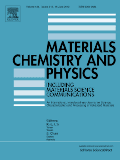
MATERIALS CHEMISTRY AND PHYSICS
Scope & Guideline
Unveiling the Secrets of Material Properties
Introduction
Aims and Scopes
- Materials Synthesis and Fabrication:
Research articles often discuss novel synthesis methods for materials, including green synthesis techniques and the use of advanced fabrication methods like 3D printing and electrospinning. - Characterization Techniques:
The journal emphasizes the use of various characterization techniques such as X-ray diffraction, electron microscopy, and spectroscopic methods to analyze the structural, optical, and magnetic properties of materials. - Functional Materials:
A significant focus is on the development of functional materials for applications in electronics, photonics, catalysis, and energy storage, including batteries and supercapacitors. - Biomaterials and Environmental Applications:
Research on biomaterials, including drug delivery systems and tissue engineering scaffolds, as well as materials for environmental remediation and pollution control is frequently featured. - Theoretical and Computational Studies:
The journal publishes articles that employ theoretical and computational methods, including density functional theory (DFT) and molecular dynamics simulations, to predict and understand material behaviors.
Trending and Emerging
- Nanomaterials and Nanocomposites:
Research on nanomaterials, particularly those that incorporate graphene or other 2D materials, is trending, as these materials show promise for applications in electronics, catalysis, and energy storage. - Sustainable and Green Chemistry:
There is a growing emphasis on sustainable practices, including the use of bio-based materials and environmentally friendly synthesis methods, reflecting a broader societal push towards sustainability. - Smart and Responsive Materials:
Materials that respond to environmental stimuli, such as temperature, pH, or light, are increasingly featured, particularly in the context of drug delivery systems and sensors. - Advanced Energy Storage Solutions:
Research into high-performance energy storage systems, particularly lithium-sulfur and sodium-ion batteries, is rapidly emerging as a critical area in response to rising energy demands. - Machine Learning and AI in Materials Science:
The integration of machine learning and AI techniques to predict material properties and optimize synthesis processes is gaining traction, indicating a new direction in materials research.
Declining or Waning
- Traditional Metal Alloys:
The focus on conventional metal alloys seems to be waning as researchers pivot towards high-entropy alloys and advanced composites that offer superior properties. - Basic Chemical Studies:
There is a noticeable decrease in publications centered on basic chemical reaction studies, as the journal increasingly emphasizes application-driven research and advanced material functionalities. - Inorganic Materials with Limited Applications:
Research on certain inorganic materials that do not demonstrate significant advancements in application or functionality is becoming less common, as the journal prioritizes innovative and impactful studies. - Low-Impact Environmental Applications:
Research concerning low-impact environmental applications of materials, such as basic filtration systems, is declining as more sophisticated and effective remediation technologies gain attention. - Single-Functionality Materials:
The trend is shifting away from materials designed for singular functions; instead, there is a growing interest in multifunctional materials that can serve multiple purposes.
Similar Journals
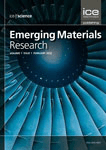
Emerging Materials Research
Pioneering research in condensed matter physics.Emerging Materials Research, an established journal published by EMERALD GROUP PUBLISHING LTD, focuses on advancing knowledge in the fields of condensed matter physics and materials science. With an ISSN of 2046-0147 and an E-ISSN of 2046-0155, this journal caters to a growing community of researchers and professionals dedicated to the discovery and application of new materials. Ranking in the Q3 quartile for both condensed matter physics and miscellaneous materials science, it provides a platform for high-quality research and innovative ideas, reflecting its relevance and engagement in the academic community. Spanning from its inception in 2012 to its ongoing editions through 2024, the journal encompasses diverse contributions, encouraging interdisciplinary approaches and fostering collaborations among scientists. Despite its open access limitations, the journal is committed to disseminating impactful research, making it an essential resource for both emerging researchers and seasoned professionals seeking to stay at the forefront of materials innovation.
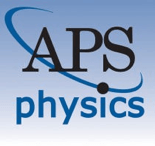
PHYSICAL REVIEW B
Illuminating the Frontiers of Materials SciencePHYSICAL REVIEW B, published by the American Physical Society, is a leading journal in the field of condensed matter physics and materials science, particularly focusing on electronic, optical, and magnetic materials. With an ISSN of 2469-9950 and an E-ISSN of 2469-9969, this periodical has garnered a prestigious reputation, achieving a Q1 ranking in both relevant categories as of 2023. The journal has recorded significant impact as reflected in its Scopus ranks, notably positioned at #95 out of 434 in Condensed Matter Physics and #75 out of 284 in the Materials Science sector, illustrating its importance in advancing research and discussions in these critical areas. Although it does not offer open access, PHYSICAL REVIEW B remains an invaluable resource for academics, researchers, and professionals seeking to increase their understanding of contemporary issues in condensed matter and material sciences. Established in 2005, this journal continues to foster innovation and dissemination of knowledge, making it a cornerstone publication for those engaged in cutting-edge research.
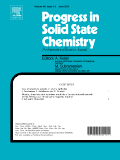
PROGRESS IN SOLID STATE CHEMISTRY
Advancing the Frontiers of Solid State ChemistryPROGRESS IN SOLID STATE CHEMISTRY, published by PERGAMON-ELSEVIER SCIENCE LTD, serves as a pivotal platform for disseminating cutting-edge research and advancements in the field of solid state chemistry. With an impressive impact factor and a respected status, this journal consistently ranks in the Q1 category across multiple disciplines, including Condensed Matter Physics, Materials Science, and Physical and Theoretical Chemistry. Following a rigorous peer-review process, it features articles that explore theoretical frameworks and experimental findings, thereby fostering innovation and collaboration among researchers and professionals. Although it does not adopt an open access model, its substantial reach and high Scopus rankings—19th in Condensed Matter Physics, 14th in Physical and Theoretical Chemistry, and 48th in General Materials Science—underscore its influence in shaping the future of materials research. Established in 1964, the journal continues to contribute significantly to the academic community, bridging the gap between theory and practical application in solid state materials.
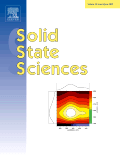
SOLID STATE SCIENCES
Pioneering Discoveries in Solid State ScienceSOLID STATE SCIENCES is an influential academic journal published by Elsevier, focusing on advancements in the fields of chemistry, condensed matter physics, and materials science. With an ISSN of 1293-2558 and an E-ISSN of 1873-3085, this journal has been at the forefront of disseminating innovative research since its inception in 1999 and is projected to continue until 2024. Positioned in the prestigious Q2 category in multiple disciplines for 2023, SOLID STATE SCIENCES ranks #87 in condensed matter physics, #101 in general chemistry, and #124 in general materials science within Scopus. Researchers and professionals in these fields will find this journal indispensable, offering open access options that enhance global visibility and accessibility of cutting-edge research, fostering collaboration and innovation. With its commitment to showcasing substantial contributions and novel methodologies, SOLID STATE SCIENCES plays a vital role in shaping the future of materials research.
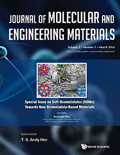
Journal of Molecular and Engineering Materials
Unveiling the Future of Molecular and Engineering MaterialsThe Journal of Molecular and Engineering Materials, published by World Scientific Publishing Co Pte Ltd, is a leading peer-reviewed journal that focuses on the intricate relationship between molecular science and engineering practices. With the ISSN 2251-2373 and E-ISSN 2251-2381, this journal aims to foster the exchange of cutting-edge research and developments within the fields of materials science, molecular engineering, and related applications. Although the journal currently does not operate under an Open Access model, it remains a vital resource for researchers, professionals, and students seeking in-depth knowledge and innovative methodologies in material design and engineering. The journal's esteemed reputation is reflected in its commitment to publishing high-quality research that addresses contemporary challenges and opportunities in material science, thereby contributing to advancements in technology and industry.

JOURNAL OF CLUSTER SCIENCE
Fostering Excellence in Cluster Science ResearchJOURNAL OF CLUSTER SCIENCE, published by SPRINGER/PLENUM PUBLISHERS, is a prominent and influential journal in the fields of Biochemistry, Chemistry, Condensed Matter Physics, and Materials Science. With an ISSN of 1040-7278 and E-ISSN of 1572-8862, this journal has been contributing to scientific discourse since its inception in 1990 and continues to publish cutting-edge research through 2024. It holds a respectable position in the academic landscape with its category quartiles indicating a Q3 ranking in Biochemistry and Q2 rankings in Chemistry, Condensed Matter Physics, and Materials Science as of 2023. The journal's noteworthy Scopus rankings further underscore its relevance, particularly a rank of #82 in Condensed Matter Physics, showcasing its impact and the quality of research disseminated. Although it does not currently offer open access options, it remains a key resource for researchers, professionals, and students who are invested in understanding the complexities of cluster science and its interdisciplinary applications.

SEMICONDUCTORS
Shaping the landscape of advanced material science.SEMICONDUCTORS, published by PLEIADES PUBLISHING INC, is a prominent journal that provides a platform for researchers and professionals in the fields of Atomic and Molecular Physics, Condensed Matter Physics, and Electronic, Optical and Magnetic Materials. With an ISSN of 1063-7826 and an E-ISSN of 1090-6479, the journal has been diligently disseminating knowledge since its inception in 1996 and continues to pave the way for innovative research until 2024. Although currently unclassified in the Open Access model, its influence is underscored by its rankings in Scopus, where it ranks in the 21st-22nd percentile across critical scientific categories. SEMICONDUCTORS serves as an essential resource for cutting-edge research, fostering a greater understanding of semiconductor materials and their applications, thereby assisting the scientific community in pushing the boundaries of technology and innovation.

Computational Condensed Matter
Advancing the Frontiers of Condensed Matter PhysicsComputational Condensed Matter, a reputable journal published by Elsevier, serves as a critical platform for advancing the understanding of condensed matter physics and related fields. Since its inception in 2014, the journal has become a pivotal resource for researchers and professionals dedicated to exploring electronic, optical, and magnetic materials, as well as materials chemistry and general materials science. With its current standing in the Q3 quartile across multiple categories in 2023, it ranks within the 60th percentile for Materials Science (miscellaneous) and the 54th percentile for Condensed Matter Physics in Scopus, reflecting its growing influence and relevance in the scientific community. The journal aims to publish high-quality, peer-reviewed articles that can foster innovation and collaboration in computational methods applied to condensed matter systems. Researchers interested in cutting-edge insights and methodologies will find Computational Condensed Matter to be an invaluable addition to their academic resources. For those seeking to contribute to or stay informed about the latest advancements in the field, this journal is a must-read.
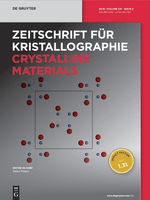
Zeitschrift fur Kristallographie-Crystalline Materials
Exploring the Depths of Crystalline InnovationZeitschrift für Kristallographie-Crystalline Materials is a prestigious academic journal published by Walter de Gruyter GmbH, focusing on the intricate field of crystallography and its applications within condensed matter physics, inorganic chemistry, and materials science. Established in Germany, this journal spans a rich history from its inception in 1930 to its convergence years from 2012 to 2024, presenting cutting-edge research and developments in crystalline materials. With an impact factor reflective of its critical role within its field—ranking Q3 in the prestigious quartiles for 2023 across multiple categories—this journal serves as an essential platform for researchers, professionals, and students seeking to expand their knowledge and contribute to the advancement of crystalline materials. While currently not offering open access, the journal remains committed to disseminating high-quality, peer-reviewed articles that inspire innovation and collaboration within the scientific community.

APL Materials
Advancing the frontiers of materials science.APL Materials is a prestigious open access journal published by AIP Publishing that has been at the forefront of disseminating cutting-edge research in the fields of materials science and engineering since its inception in 2013. With an impressive impact factor reflecting its significance, APL Materials ranks securely in the Q1 quartile in both Engineering (miscellaneous) and Materials Science (miscellaneous) categories, underscoring its role as a vital resource for innovative scientific inquiry. Ranked highly in Scopus, particularly in General Engineering (24/307) and General Materials Science (78/463), the journal provides a platform for researchers, professionals, and students to share their findings and advancements that push the boundaries of material applications. Furthermore, its open access policy ensures that high-quality research is freely available to a global audience, fostering collaborative advancements in the scientific community. As the journal continues to evolve through to 2024, it remains committed to presenting groundbreaking studies that contribute to the advancement of materials science and engineering disciplines.Explore APL Materials to stay at the cutting edge of research and innovation.